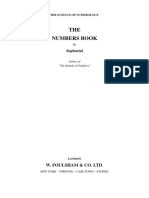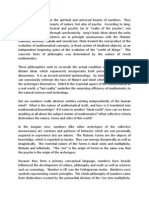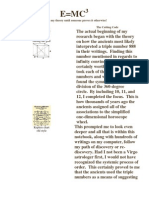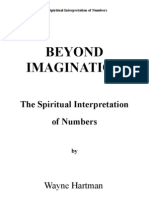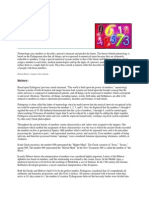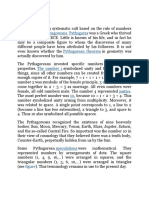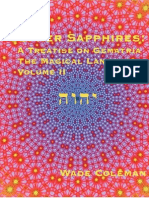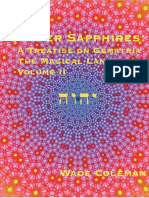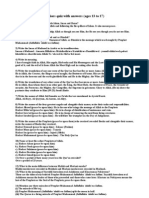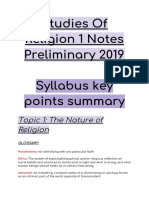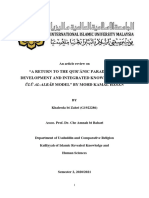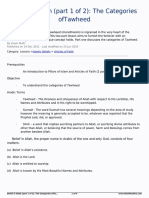Numbers: Sequence, Shape, and Psychodynamics
Introduction
The provided sources explore the multifaceted nature of numbers, moving beyond their mere
quantitative function to delve into their inherent qualitative, geometric, and even mystical
dimensions. From ancient philosophical and religious traditions like Sufism and Pythagorean
arithmology to modern neuropsychological studies and numerological interpretations, numbers
are revealed as fundamental to human perception, thought, and the very fabric of existence.
Key themes revolve around the innate human capacity to perceive and understand numbers,
their symbolic connections to cosmic principles, and the historical development and global
adoption of the Indo-Arabic numeral system.
The Intrinsic Nature of Numbers: Beyond Quantity
Numbers are not merely abstract concepts for counting; they possess inherent properties and
deeper meanings that resonate with human experience and the natural world.
• Multifaceted Nature of Numbers: Numbers possess "value," "shape," "sequence," and "sound."
As one source states, "take away any one of these things and the concept falls apart." This
holistic view is crucial to understanding their profound impact.
• Innate Perception and Psychological Reality: Humans (and even some animals) have an
"innate number sense," allowing direct perception of small quantities without counting. This
suggests an "objective psychological reality" for numbers, rooted in the "neurodynamics of the
brain." Specifically, a region in the right posterior parietal cortex is identified where small
numbers (one to seven) are represented, with more area devoted to smaller, more accurately
perceived numbers.
• Archetypal Numbers: Certain numbers, particularly the first four (Monad, Dyad, Triad, Tetrad),
are considered "archetypal." They are "innate, unconscious psychodynamical Forms inherent in
the human psyche," possessing "qualitative psychological effects in addition to the quantitative
properties." These archetypal numbers are described as "potent and numinous in human
experience" and are fundamental to depth psychology.
◦ Four Principal Aspects: Marie Louise von Franz, a student of C.G. Jung, outlines four
aspects of numbers: Quantitative, Geometric, Algebraic, and Qualitative. Qualitatively, each
archetypal number has an individual character.
• Imagination and Perception: Our innate understanding of numbers extends to their
visualization. We can easily imagine small numbers arranged in patterns (e.g., Pythagorean
figurate numbers) and perceive various types of symmetry (reflection, translation, rotational).
These visualizations are considered their "archetypal images."
Hidden Symmetries and Natural Pairs
A central discovery highlighted in one source is the "hidden symmetry" and "pairing of numbers"
that "seem to have eluded previous research" in numerology. These pairings reveal deeper
metaphysical and geometric relationships.
• Identified Pairs: The research by Raziel Ali identifies the following natural pairs based on their
geometric and sequential relationships:
◦ 6 and 9: Very similar shape, just flipped on each other.
◦ 2 and 5: Very similar shape, just rotated.
◦ 3 and 8: 3 is "literally like half of an eight."
� ◦ 4 and 7: Made of strictly lines, put together they make boxes.
◦ 0 and 1: Are alike and different, "literally opposites of each other to Something in the nothing
the beginning of the return."
• Metaphysical Interpretations of Pairs:
◦ 0/1 (Void and Creation): 0 represents the unmanifest void, and 1 symbolizes the "first act of
creation," manifesting from nothing. This pair encapsulates the "cycle of creation and
dissolution," a "continuous loop between creation and dissolution."
◦ 2/5 (Curves and Lines Flipped): 2 symbolizes duality and balance, while 5 represents action
and transformation. Their geometric symmetry, when flipped, illustrates a "natural progression
from stability to change," where duality and transformation are complementary.
◦ 3/8 (Cycles of Creation and Infinity): 3 represents creativity and growth, and 8 symbolizes
balance and infinity. The visual connection of 3 being half of 8 suggests that "all acts of creation
(3) are part of an infinite cycle of existence (8)."
◦ 4/7 (Structured from the Same Elements): Both 4 and 7 are made of straight lines and right
angles. 4 represents "material stability," and 7 spiritual insight. This connection suggests that
"spiritual growth is grounded in the stability of the material world."
◦ 6/9 (Spirals of Love and Fulfillment): These are rotationally symmetrical. 6 represents "love
and nurturing," and 9 symbolizes "completion and wisdom." Their rotation demonstrates how
"personal love expands into universal fulfillment."
• Implications of Pairs: This symmetrical structure suggests that numbers "carry encoded occult
knowledge about the structure of reality," unifying material and spiritual worlds. The exploration
of these pairs led to the creation of "NUMO" (pronounced "new mow"), a simple numerology
reading system.
Sufism and the Mystical Authority of Numbers
Sufism, a mystical branch of Islam, offers a spiritual lens through which to understand numbers,
emphasizing their divine origin and authority over existence.
• Numbers as Divine Secrets: The source claims that integers contain "mystical features"
originating from "divine secrets of the prophets sent by God." These secrets were preserved in
Islam, particularly through the Quran, Hadith, and Islamic scholars' discoveries.
• Sufistic Analysis of Numbers:
◦ Numbers have Authority: "Numbers have authority over the realm. The changes and
formations in the nature are subject to certain integers."
◦ 1 (Essence of Numbers, Divine Unity): The number 1 is not considered a number in Sufism
but "the essence of the numbers," as all numbers emerge from it. It is analogous to "Tawheed
(uniting of God)" and symbolizes "divine unity." Ibn Arabi equates 1 with the name of Allah,
which gathers all other names of God.
◦ 2 (Duality and Realm): 2 is "the number of realm" and symbolizes "opposing groups" and
the "deeply distressed realm in which we live." This reflects the Quranic verse, "We created
everything in pairs." Examples include breath (in/out), heart movements (compression/release),
electrical charges (warmth/coldness), and male/female.
◦ 3 (Divine Creation and Structure): 3 is the "first of the odd integers" and the "number of the
divine creations." The Arabic word for "Be!" (referring to God's creation command) is made of
three letters. The world, according to Ibn Arabi, has a triple structure (essence, adjective,
�connection), and human procreation results from the union of male and female, similar to 3
being derived from 1+2.
◦ 4 (Widest Authority, Perfection): 4 has the "widest authority" and signifies perfection, as
1+2+3+4=10 (perfection). It's associated with "Sıddıqs" (most loyal people) and the four-month
period of vigor and youth (April).
◦ 6 (Completion and Perfection): 6 is a "perfect number" in mathematics (1+2+3=6) and in
Sufism indicates "completion or perfecting." The world was created in 6 days. It also represents
six unique features of Prophet Muhammad.
◦ 7 (Peak of Perfection): 7 is the "peak of the perfection in the divine science," with Sufi
chanting repeated at least 7 times. There are 7 mobile planets and 7 people in the highest
spiritual positions governing the universe.
◦ 10 (Perfection Property): 10 has the "perfection property," influencing human life in 10-year
periods.
◦ 12 (Zodiacal Constellation, Order): 12 is the number of zodiacal constellations and orders
for numbers (1 to 9, then 10, 100, 1000).
◦ Other Significant Numbers: 14 (Quranic letters, double of 14 for surahs, divine stages in
sky), 28 (second perfect number), 33 (prayer beads), 40 (maturity, prophethood age, Sufi
training), 70 (unlimited multiplicity), 100 (degrees in heaven and hell).
• Imagination as a Divine Gift: Numbers arise from human imagination, which is seen as a divine
gift. God assigns concepts to human imagination, which are then perceived by reason. This
power of imagination makes humans "superior to other living things."
Psychodynamics of the First Four Archetypal Numbers
Building on the concept of archetypal numbers, the psychodynamics perspective explores their
qualitative effects on the human psyche.
• Monad (Unity, Wholeness, Potential):
◦ Paradoxical Unity: The Monad "contains everything potentially," including opposing
actualities. It is akin to the Jungian "Self," the "central core of the personality" that is "absolutely
paradoxical," representing thesis, antithesis, and synthesis.
◦ Androgynous Nature: Called "Androgyne," it is neither male nor female, preceding sexual
differentiation, and is the principle of form and matter. The Self is also described as
hermaphroditic.
◦ Obscurity and Fertility: The Monad is "dark and obscure," like "creative Chaos," representing
an "uncritical unconsciousness" that is nevertheless "fertile" and wants to differentiate.
◦ Self-Producing and Guiding: It generates itself and everything else, similar to God regulating
the universe. The unconscious Self regulates the psyche and guides psychological
development.
◦ Form of Forms, Nous: It is the "form of forms," "Creation," and "Intellect," containing all
governing ideas (archetypes) of the cosmos.
◦ Coherence and Stability: The Monad imparts coherence and harmony, symbolizing
"wholeness and integrity."
◦ Two Aspects: It is both an all-inclusive whole (hen-to-pan) and a unit in multiplicity, giving up
its quality to become quantity. It is the Dyad in potentia.
• Dyad (Division, Duality, Conflict, Manifestation):
� ◦ Principle of Division: The Dyad is the "source of difference and inequality," underlying
division and creating the definite Dyad from the Monad.
◦ Movement and Change: It is the first to separate from the Monad, representing "movement
and change," "daring," and "impulse." It symbolizes "the process of facing and enduring
conflict."
◦ Transition to Consciousness: The Dyad makes unconscious conflict manifest in
consciousness, bringing "discrimination" and revealing "a twofold oneness."
◦ Matter and Flux: Called "matter" and "the fount of flowing and liquidity," it is the origin of the
"flux of material reality."
◦ Repetition and Symmetry: The Dyad generates "translational or repetitive symmetry" and
"mirror symmetry."
◦ Tension and Resolution: It creates a tension between opposites that demands release,
seeking resolution in the Triad. The oscillation is directionless, with inherent direction coming
from the Triad.
• Triad (Synthesis, Completion, Direction, Wisdom):
◦ Restores Unity: The Triad emerges as a synthesis of the Dyad's tension, restoring unity in a
knowable form. It is called "Harmonia" because it unifies opposites.
◦ First Actual Number and Totality: It is the first number to actualize the Monad's potential and
signifies totality (beginning, middle, end).
◦ Synthesizes Predecessors: 3 = 2 + 1, integrating the Monad and Dyad.
◦ Centering and Progression: The Triad "centers bilateral symmetries and initiates linear
succession." It brings a direction to the process, unlike the reversible Dyad, and is associated
with the three parts of time (past, present, future) and three spatial dimensions.
◦ Prudence and Wisdom: It is called "Prudence and Wisdom" due to its orientation in time.
◦ Emergence of Self: As a resolution of dualistic conflicts, the "real Self can emerge," leading
to "true coherence, substance, and individuality."
◦ Fate and Synchronicities: Associated with the Three Fates, it relates to the "correspondence
of inner and outer events" (synchronicities) and unifies heavenly and earthly worlds.
• Tetrad (Wholeness, Completion, Stabilization, Embodiment):
◦ Full Completion: Represents "wholeness and full completion." It is the "begetter of the
Decad" (1+2+3+4=10).
◦ Psychological Wholeness: Jung devoted much work to the Tetrad's significance as a symbol
of "psychological wholeness and integration," as unconscious content becomes subject to the
four functions of consciousness (perception, thought, feeling, intuition).
◦ Return to Conscious Monad: It leads back to the Monad, but as a "consciously articulated
whole," rather than an undifferentiated plenum.
◦ Embodiment and Solidity: The Tetrad signifies "minimal and most seminal embodiment," as
the elementary body (fire) is shaped like a tetrahedron (four sides, four corners).
◦ Stability and Justice: It represents a new level of psychological integrity, being "hard to
dissolve" and "binds everything." Associated with "Justice" (a square whose area and perimeter
are equal).
◦ Transcendence into Time and Space: It brings the "transcendent Triad into time and space,"
moving from "infinitely conceivable to finite reality."
� ◦ Four Levels of Consciousness: The first four numbers define progressive levels: I. Uncritical
unconsciousness, II. Dualistic tension, III. Gnosis (unity in higher world), IV. Ego as herald of
universal truths (conscious interpretation of divine revelations).
◦ Integration of Inferior Function: Advancing to the Tetrad requires integrating all four functions
of consciousness, including the "inferior function" and embracing one's "Shadows."
◦ Quincunx and Quintessence: The centered square (quincunx) points to the "quintessence,"
the "most refined, spiritually imaginable unity of the four elements," linking to the Pentad.
The Global Victory of the Indo-Arabic Numeral System
The adoption of the Indo-Arabic numeral system represents a significant chapter in the history
of mathematics, driven by its inherent superiority despite initial resistance.
• Indian Origin and Superiority: The system originated in India, "long before most probably in the
pre-Christian era." It proved "victorious over all other systems" due to its efficiency in handling
"very large numbers" with only ten distinct symbols (0-9).
• Slow Acceptance: Despite its advantages, its acceptance was slow in Europe due to "strong
prejudice and national bigotry."
• Role of Arabs and Persians: The decimal place-value system and the concept of zero traveled
from India to Arabia, then to Europe. Arabic and Persian mathematicians were crucial in its
dissemination. Al-Khwarizmi's book, The Book of al-Khwarizmi on Indian Numerals, referred to
the numbers as "Indian."
• Copernicus's Endorsement: Nicolaus Copernicus, in his groundbreaking work De
Revolutionibus Orbium Coelestium (1543), praised the "excellence of the Indian numerals,"
using them for large number designations in his tables. He recognized their "computational
speed."
• Obstacles to Adoption:
◦ Material Causes: Medieval European computations were primarily done with mechanical
means (abacus, counters), so written calculation was not a practical necessity for merchants.
◦ Lack of Scientific Need: There was "no scientific need" for the new numerals for a time, as
their implications for radical new arithmetic were not widely realized.
◦ Fear of Misuse: The Church was wary of the system, fearing that "usurers and other
underhand dealers" might misuse it for illicit transactions.
• Global Unification: The Indo-Arabic decimal system eventually gained "wide currency" globally,
not by force, but by the "merit of its superiority over all other systems." It serves as a "unifying
power of the science of numbers."
• International Spirit of Science: The adoption of the Indian numerical notation by the rest of the
world highlights that science is "international in spirit" and should not be hindered by "national
narrowness and bigotry."
